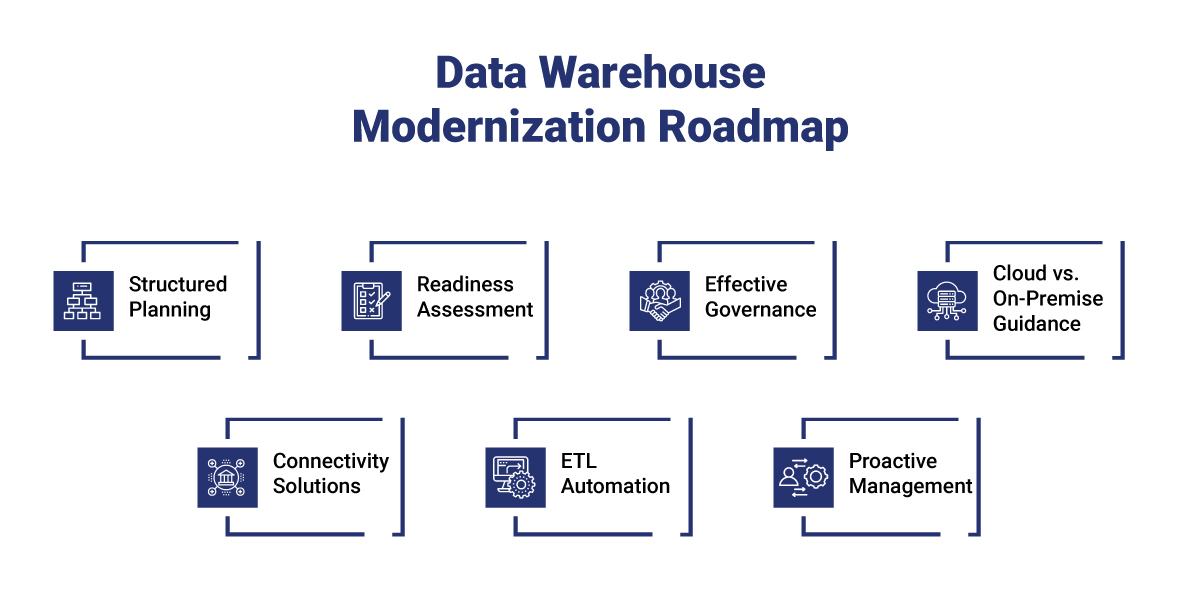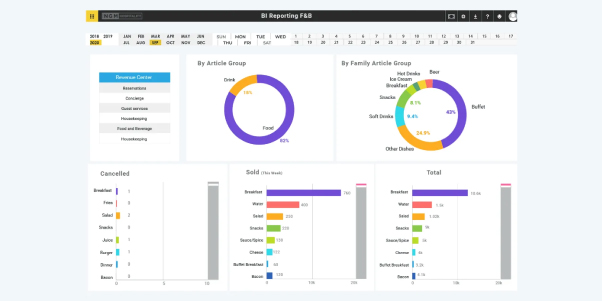Organizations understand the importance of capturing mission-critical data, but they often fail to realize that traditional data warehouses are hindered by limited scalability, growing operational overheads, and an inability to generate real-time insights or advanced analytics. Therefore, Data warehouse modernization becomes a strategic imperative to integrate advanced technologies and adopt new architectural paradigms for a data-first enterprise.
Legacy data warehouse modernization comes with several business benefits. A centralized data repository, better decision-making capabilities, improved data quality, efficient data analysis, and enhanced scalability are just a few! If you too are looking to capitalize on this game-changing impact of DWH modernization, then this blog covers everything you need to know. Explore the key drivers for modernizing your data warehouse along with the most effective implementation methods and how we can help you make a smooth transition.
Why Data Warehouse Modernization is a Must in the Digital Era
Traditional data warehouses struggle to handle rapidly expanding data volumes efficiently, hindering data-intensive operations. Their rigid structures with limited scalability, high maintenance cost and data silos make it difficult to adapt to changing business needs, impeding the integration of new data sources and analytics capabilities. These systems often encounter challenges in processing data in real-time, slowing down decision-making processes that rely on up-to-date information.
Challenges of Legacy Data Warehouses
- As data volumes and diversity surge relentlessly, traditional warehouses struggle to accommodate the influx. This leads to performance constraints and delayed query responses.
- Integrating data from diverse sources becomes a hurdle, resulting in data silos and fragmented business perspectives that result in missed business opportunities and compromised agility.
- Traditional data warehouses incur high maintenance expenses for hardware, software upgrades, and an in-house team of IT personnel.
- The inflexibility of legacy data warehouses hinders scalability and agility, making it difficult to adapt to evolving data requirements.
- Conventional data warehouses are prone to failures, impacting business continuity and decision-making processes due to issues such as data quality and hardware failures.
- Maintaining data quality becomes challenging when integrating data from multiple sources, leading to discrepancies and false decision-making.
The need to modernize comes from important reasons that focus on improving business performance, preparing for the future, saving costs, and making better decisions.
Compelling Reasons to Modernize Legacy Data Warehouses
- Cloud-based data warehouses provide elastic scalability, enabling businesses to scale storage and processing power based on needs. They also process information quicker, facilitating faster business decisions.
- DWH modernization prepares progressive businesses for future challenges by establishing a scalable data ecosystem that adapts to technological developments.
- Modern data warehouses reduce infrastructure expenses and maintenance costs, optimizing resources and streamlining operations.
- Modern data warehouses can integrate with AI and ML models to provide predictive analytics and automated, timely, accurate insights, empowering organizations to make informed decisions, critical to gain a competitive edge.
With the global Cloud Data Warehouse market projected to reach $12.9 billion by 2029[1], investing in modern data warehouse solutions becomes a top priority for enterprises seeking to unlock enhanced operational efficiency and strategic growth opportunities. For more details, you can explore this insightful read on the cloud data warehouse market and future trends.
Key Drivers of Data Warehouse Modernization
Exponential growth in data volume, velocity, and variety of data necessitates the modernization of your existing data warehouse to support big data and new business technologies. Data warehouse modernization is helping businesses become a data-first enterprise where informed decisions can drive financial success. Progressive businesses are also decommissioning their existing DWHs and replacing them with the ones that are optimized for modern-day requirements in big-data, analytics, and real-time insights. The top trends that are driving the need for EDW modernization boil down to these three top factors:
Business Drivers:
- Evolving business needs: As businesses expand, they require more data aligned with their goals. However, over time, data warehouses struggle to meet the demands for accurate and timely insights needed to support new business requirements.
- Swift and Seamless collaboration Business and IT teams must be able to communicate easily to work at optimal efficiency. Technical glitches, delays in generating analytics reporting and such similar complications can often impede collaboration. A modern data warehouse helps bridge the gap and ensure consistent, close-knit collaboration between the teams.
- Self-service BI and analytics: Businesses today rely on reports and actionable insights generated from data for actionable insights. However, legacy warehouses hinder the speed and volume of data needed for self-service BI tools, impacting business agility and decision-making.
Technological Drivers:
- Designed for modern platforms and systems: Staying updated with technological advancements, such as no-code ETL tools and automation platforms, improves efficiency and enables agile decision-making.
- Easy adaptation to new data types: Modern data comes in various formats, including structured, semi-structured, and unstructured. Legacy DWH modernization allows data warehouses to process and store different data types quickly and efficiently.
Strategic Drivers:
- Scalable, flexible architecture: Legacy data warehouses often struggle to accommodate evolving business requirements and growing data volumes. Modern data warehouse architectures offer scalability and flexibility to adapt to changing needs.
- Enhanced security, privacy, and governance: Compliance with regulations like GDPR necessitates improved data governance and security measures. DWH modernization ensures better compliance and traceability.
- Cost reduction: Modern data warehouse tools simplify data warehouse maintenance and reduce costs through unified platforms, low-code development environments, and quick iteration capabilities, optimizing resource utilization.
Key Benefits of Accelerating Data Warehouse Modernization in 2024
In the digital era, where data reigns supreme, modernizing your traditional data warehouse is not just an upgrade. It’s a strategic imperative that ensures a data-first enterprise. Here are ten ways data warehouse modernization can help you unlock the full potential of your enterprise’s data wealth:
- Cloud-based data warehouses can handle any data type – structured financial transactions, semi-structured emails, or unstructured images for a holistic view.
- With real-time data processing, businesses can extract actionable insights from continuous data streams for swift and informed decision-making.
- Compatibility with popular and powerful data processing engines including Apache Spark, Apache Flink, Hadoop for real-time data ingestion and analytics.
- You can harness the full potential of cloud technologies for improved scalability, processing power, and enhanced security for faster deployment and to easily adapt to changing business needs.
- From on-premises to multi-cloud or hybrid cloud models, data warehouse modernization offers flexibility and interoperability across various environments.
- It enables users with different roles and needs to easily access data with self-service querying capabilities, catering to the needs of data scientists, analysts, and report writers.
- Breaks down data silos by integrating the data warehouse with other platforms. This helps create a unified ecosystem and one single source of truth for smooth data management.
- Automates tedious tasks like data ingestion and transformation, accelerating analyses and improving accuracy, freeing up resources for more strategic initiatives.
- Integrates AI and Machine Learning algorithms for automated data integration, cleansing, and stream processing for enhanced efficiency and informed decision-making.
- Ensures compliance with robust cybersecurity features and data governance policies, safeguarding enterprise data assets and promoting trust and integrity.
Let’s now move to the methods that can lead you there. Whether you want to rebuild from scratch or update your existing setup, you have both options available, depending on your business priorities and requirements. Here are six effective methods for modernizing data warehouses:
Most Effective Methods for Data Warehouse Modernization
Enterprises can customize and choose any of the following approaches based on your business priorities, needs, and goals:
1. Data Warehouse Automation
- This strategy involves using software tools to automate various time-consuming tasks involved in managing a data warehouse. These tasks include data integration, transformation, consolidation, loading, and generating SQL code for querying.
- Automation reduces the need for manual intervention, making processes more efficient and less prone to errors.
- It is particularly useful for handling large volumes of data and complex analytical workloads, as it streamlines the entire data warehouse lifecycle.
2. Migrate On-Premise Systems to the Cloud
- Cloud data warehousing involves migrating on-premise data warehouses to cloud-based platforms, such as Amazon Web Services (AWS), Microsoft Azure, or Google Cloud Platform.
- By leveraging cloud infrastructure, businesses can achieve greater scalability and flexibility without the need to invest in additional hardware.
- Cloud-based data warehouses also offer seamless integration with other cloud applications, facilitating efficient data sharing and collaboration across the organization.
- This approach includes different deployment models, such as multi-cloud and hybrid cloud.
3. Operational Data Warehouses
- Unlike traditional data warehouses that focus on historical data analysis, operational data warehouses are designed to support real-time analytics and reporting.
- These warehouses are optimized for handling continuous data streams and providing insights in near real-time.
- They often include user-friendly self-service querying features, allowing non-technical users to access and analyze data without relying on IT support.
4. Data Lake Integration
- Integrating data warehouses with data lakes allows organizations to combine structured and unstructured data for advanced analytics.
- Various architectural frameworks facilitate this integration, enabling organizations to choose the approach that best fits their business needs.
- The emerging concept of a “Data Lakehouse” combines the benefits of data warehouses and data lakes to support diverse workloads and storage formats.
5. Extend Existing Data Warehouse
- In cases where companies need to retain legacy systems for compliance or security reasons, extending an existing data warehouse is a viable option.
- This strategy involves integrating legacy systems with modern tools and cloud platforms to enhance scalability, agility, and performance.
- It allows you to preserve select legacy components while introducing new functionalities and automation capabilities to meet evolving business needs.
6. Greenfield Development
- Greenfield development involves building a new data warehouse initiative from scratch.
- This approach allows you to design a data warehouse architecture that meets your specific requirements and objectives.
- It offers benefits such as simplified implementation of standards, hyper-customizability, and scalability, especially when deploying on cloud-based platforms.
When legacy systems must be retained for compliance or security, extending an existing data warehouse becomes a viable option. This involves integrating your legacy sources with modern tools and cloud platforms to boost scalability and agility. It helps maintain certain legacy components while incorporating new functionalities and automation features.
At Rishabh Software, we understand that data warehouse modernization is imperative for enterprise growth. With our extensive expertise in ETL tools, database systems, data modeling and solution architecture, we excel in standardizing data and optimizing processes. Our deep domain knowledge ensures adherence to regulatory and compliance norms.
Rishabh Software’s Data Warehouse Modernization Roadmap
Modern Data Warehouses are mission-critical for modern enterprises that are driven by the vast opportunities of big data. That is why our personalized data warehouse consulting services account for your industry niche, business vertical, and business requirements, ensuring successful modernization efforts with confidence.

Structured Approach:
- Our consultant defines a clear roadmap for efficient and cost-effective data warehouse modernization that aligns with your business goals and budget.
- We prioritize business needs to deliver tangible benefits to your organization.
Readiness Assessments:
- Before modernization, it’s crucial to assess readiness for change. We conduct comprehensive assessments to identify potential disruptions and develop strategies to mitigate risks.
Effective Governance:
- Establishing data governance is crucial for data integrity and security. We help design and implement robust frameworks that comply with regulatory requirements.
Cloud vs. On-Premise: Guidance on Options:
- We offer guidance on selecting between cloud-based or on-premise solutions. Our team evaluates factors like scalability, security, and compliance to determine the best fit for your needs.
Connectivity Solutions:
- We also provide connectivity solutions to maximize the value of your modernized data warehouse.
- Ensuring seamless integration with other systems allows for efficient data sharing and collaboration.
ETL Automation:
- Automating the ETL process accelerates development and deployment.
- We leverage automation tools to design efficient pipelines, minimizing manual intervention.
Proactive Management:
- Managing technical debt ensures long-term sustainability and performance.
- We identify and address design and coding issues promptly to prevent accumulation, optimizing database storage and metadata management.
Let’s now examine how our data warehouse modernization services helped our client establish a centralized data warehouse. This unified system acts as a single source of truth, empowering stakeholders to extract valuable insights.
Cloud-Based Data Warehouse Success Story
A leading US-based hospitality giant was facing data management challenges due to multiple business acquisitions and the use of diverse applications like PMS, POS, and analytics tools. Through strategic planning and technology implementation, we enabled our client with a centralized data warehouse system. This enabled them to unlock valuable insights and drive informed decision-making across their business units.

Challenges:
- Disparate data silos leading to redundancies
- Inflexible BI reporting for evolving needs
Our Solution:
- Comprehensive data understanding and model mapping
- Creation of an operational data store (ODS)
- Development of ETL routines and data warehouse
- Implementation of scalable business intelligence tools
Results:
- 50% increase in workflow efficiency
- 40% reduction in data quality issues
- 99% accurate business insights
Learn how we assisted a hospitality giant in managing disparate data from 20+ sources in this detailed cloud data warehouse solution for the hospitality business case study.
Frequently Asked Questions
Q: What are the top considerations for modernizing a data warehouse?
A: The key factors to consider for a smooth and successful data warehouse modernization are as follows:
- Assess Current Infrastructure: Understand the existing data warehouse setup, including hardware, software, and data architecture.
- Define Objectives: Clearly outline the goals and objectives of modernization, such as improving performance, scalability, and agility.
- Evaluate Data Quality: Ensure that data quality is assessed and addressed as part of the modernization process to maintain accuracy and reliability.
- Consider Scalability: Plan for future growth and scalability requirements to accommodate increasing data volumes and user demands.
- Embrace Cloud Technologies: Explore the benefits of cloud-based data warehouse solutions for enhanced flexibility, scalability, and cost-effectiveness.
- Address Security and Compliance: Implement robust security measures and ensure compliance with industry regulations and data privacy standards.
- Enable Advanced Analytics: Incorporate advanced analytics capabilities, such as machine learning and AI, to derive deeper insights from data.
Q: What are the emerging trends in data warehouse modernization?
A: Emerging trends include:
- Adoption of Cloud-Native Architectures: Enterprises are increasingly migrating to cloud-native data warehouse platforms for greater agility, scalability, and cost efficiency.
- Integration of Big Data Technologies: Incorporating big data technologies, such as Hadoop and Spark, to handle diverse data types and large volumes of data for advanced analytics.
- Emphasis on Real-Time Analytics: Shift towards real-time data processing and analytics to enable faster decision-making and responsiveness to business events.
- Rise of Data Lakes: Integration of data lakes with traditional data warehouses to store and analyze structured and unstructured data in a unified environment.
- Use of Artificial Intelligence and Machine Learning: Leveraging AI and ML technologies to automate data management tasks, enhance predictive analytics capabilities, and uncover actionable insights.
- Focus on Data Governance and Compliance: Heightened focus on data governance, privacy, and compliance to ensure that modernized data warehouses adhere to regulatory requirements and industry standards.
Q: Why modernize your data warehouse with us?
A: Here’s what we bring to the table as your trusted technology partner:
- Expertise: Our team of experienced professionals specializes in legacy data warehouse modernization and possesses the skills and knowledge needed to deliver successful outcomes.
- Experience: With a proven track record of executing EDW modernization projects across diverse industries, we bring invaluable experience to the table.
- Authority: As leaders in the field of data management and analytics, we have earned the trust and recognition of our clients.
- Trust: We prioritize transparency, accountability, and integrity in all our engagements, building trust and confidence with our clients.
Q: List tried and tested data warehouse modernization strategies.
A: Here are some strategic approaches to address the complexities of DWH modernization and tap the full potential of your data ecosystem:
- Transitioning from on-premises data warehouses to cloud-based platforms like AWS Redshift, Google BigQuery, or Azure Synapse Analytics.
- Data Virtualization: Implementing data virtualization solutions to enable real-time access to disparate data sources without physical movement or replication.
- Data Lakes Integration: Integrating data lakes with traditional data warehouses to leverage the scalability and flexibility of Hadoop or Spark for big data analytics.
- Modern ETL/ELT Processes: Adopting modern Extract, Transform, Load (ETL) or Extract, Load, Transform (ELT) processes using tools like Apache NiFi or Talend.
- Self-Service Analytics: Empowering business users with self-service analytics capabilities through tools like Tableau, Power BI, or Looker for faster insights.
- Data Governance Framework: Establishing robust data governance frameworks to ensure data quality, consistency, and compliance across the modernized data warehouse.
- Hybrid Architectures: Implementing hybrid data warehouse architectures that combine on-premises and cloud-based components for flexibility and cost optimization.
- Containerization and Microservices: Containerizing data warehouse components and adopting microservices architectures for greater agility and scalability.
Footnotes:
1. https://www.marketsandmarkets.com/PressReleases/data-warehouse-as-a-service.asp











 30 Min
30 Min


